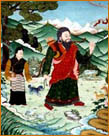
Tantric Initiation in the TraditionsJames Steinberg
The following
is an excerpt taken from Love of the God-Man. In this piece, James
places sexuality in the broader context of the process of Realizing Reality Itself.
He discusses three Spiritual Realizers, and points out that, while parts of their
stories can be attributed to folklore, what remains true is the communication
of the necessarily positive place sexuality must have (and inherently does have)
when Truth or Reality Itself is to be Realized.
In the Hindu Tantric tradition three varieties of Teachers and practitioners are described. The “vira siddhas” or “heroes” were those who taught through using sexuality (as well as other “pleasures of life, such as alcohol and meat, which were normally forbidden), and they were known as the followers of the “left-handed path” (of Tantra). It was acknowledged that most people were not qualified for such a Way, which was fraught with the potential danger of attachment to sensuality and indulgence. The “pasus” were the ordinary types, or bodily-based individuals, who were instructed to live a more conventionally disciplined householder’s life. And there were also those viewed as “pure” or “sattvic” [balanced] types, who lived a very ascetical and celibate lifestyle. The viras were known to be those of the greatest vigor, and the Way Taught and practiced by them involved the conscious use of practices shunned by the pure and (typically) indulged to excess by the pasu. These practices included drinking alcohol, engaging in sexuality, and eating cooked meat. In the West, the rich Tantric tradition is largely unexplored, primarily because most of its source Teachings were never written down, and of those that were, much remains misunderstood or has not yet been translated into English. If sexual initiation is performed by a Sat-Guru, it is essential that the devotee by rightly prepared, for the un-Enlightened devotee may project his or her limitations on the Sat-Guru and associate with him (or her) in an ordinary way. In such a case the great Gift of Blessing granted through sexual relations with an Adept is not fully or rightly received. Further, the devotee who fails to understand or even receive the Instruction and Initiation that is given through the Realized Sat-Guru’s involvement with sexuality may develop misconceptions and misunderstandings.  The
Spiritual
biography of the Tibetan “Crazy-Wise” Adept Drukpa Kunley (1455-1570) is a
testimony to the use of sexuality by Adepts in traditional Spiritual cultures
as a means to Teach and Liberate. Drukpa Kunley was a “Naljorpa”, or wandering
Realizer, who was full of magical siddhis [spiritual powers]. Although
he had formal monastic training, he is best known for his “Crazy-Wise” actions
all over Bhutan and Tibet.
It is said that he had over five thousand “girlfriends”, of whom thirteen were
his favorites. His exploits are full of shock tactics, humor, and utter lack of
inhibition. There are numerous recorded examples of his ribald poetry and his
sexual play with women. Sex and chung (Tibetan beer) are all he seems to be interested
in — but this is just his “cover” by which he tests those around him. The
Spiritual
biography of the Tibetan “Crazy-Wise” Adept Drukpa Kunley (1455-1570) is a
testimony to the use of sexuality by Adepts in traditional Spiritual cultures
as a means to Teach and Liberate. Drukpa Kunley was a “Naljorpa”, or wandering
Realizer, who was full of magical siddhis [spiritual powers]. Although
he had formal monastic training, he is best known for his “Crazy-Wise” actions
all over Bhutan and Tibet.
It is said that he had over five thousand “girlfriends”, of whom thirteen were
his favorites. His exploits are full of shock tactics, humor, and utter lack of
inhibition. There are numerous recorded examples of his ribald poetry and his
sexual play with women. Sex and chung (Tibetan beer) are all he seems to be interested
in — but this is just his “cover” by which he tests those around him.The portrayal of such outlandish and compassionate behavior,
even if the actual events themselves have become mythologized by time, is
meant to illustrate both the Spiritual Instruction inherent in the Realizer’s
every action, and his Freedom from all conventional limitations on behavior. Drukpa
Kunley travels like a beggar or a huntsman, with hunting bow and dog by his side.
But in every situation, it becomes clear that all of his actions and speech are
motivated by compassion. His words and deeds bring freedom to everyone he encounters,
and his sexual exploits (in particular) are both initiatory and liberating. With
ordinary folk and with the monks of his time, he sports and plays, appearing flippant,
but always most intently and directly penetrating any situation with the Wisdom
of the Real Condition. On
one occasion, in a southern valley of Bhutan, he is requested by a group of wealthy
men and women to Bless them with a discourse on the Buddha’s Teachings. “Tell
us something”, they ask, “serious in content, but with some touches of humor”,
in the language of common people, but with “a profound inner meaning”. In response,
the mad Lama delivers a typically explicit, madly humorous, and sharply critical
discourse, in the style of the Buddhist enumeration of numbered truths:
The discourse is more extended than space allows here, but it is reported that after it was over, the grateful listeners cried and laughed, and left Drukpa Kunley’s company with great faith and devotion. Over and over it is reported that Drukpa Kunley meets a woman, has sexual relations with her, and then leaves her with Instructions to continue to practice and meditate. In many cases it is described that such fortunate ones achieved advanced states of Realization. In Hinduism, the archetypal sexually alive Adept is Krishna, who is also the most beloved Spiritual hero. With great relish, stories are told of Krishna’s sexual union with the Gopis on the banks of the Yamuna river in Vrindavan. The fullness of this tradition, as explored by Jayadeva in his Gita Govinda, depicts in beautiful erotic verse Krishna’s trysts with his favorite, Radha. All of the Gopis are in fact married women, who leave their husbands in the night to be with Krishna. There are many who claim that the stories of Krishna were intended only as allegory, and that it is not really being suggested that he was sexually involved with the Gopis at all [and that Krishna himself is a metaphor for the incarnate Divine Person, but who never really existed]. But within the context of the stories about Krishna themselves, this is clearly not the case. Krishna’s love exploits are described in great detail in order to explicitly communicate the passionate, irresistible attraction that the women of Vrindavan had for him. There is a story, for example,
in the Bhagavata Purana of Krishna’s meeting
with a hunchbacked woman, Trivakra, on his way to battle with the wicked king
Kamsa. She offers Krishna some sandalwood unguent, and
Krishna, seeing her devotion and pleased with her, heals
her back. He tells her that he will come to her house after Kamsa is defeated.
|
 Birth, Life & Death
Birth, Life & Death


186,104 people have liked our site's pages and shared them with their Facebook friends - Most Shared Pages
© 2025 Copyrighted materials used with the permission of The Avataric Samrajya of Adidam Pty Ltd, as trustee for The Avataric Samrajya of Adidam. All rights reserved. None of these materials may be disseminated or otherwise used for any non-personal purpose without the prior agreement of the copyright owner. ADIDAM is a trademark of The Avataric Samrajya of Adidam Pty Ltd, as Trustee for the Avataric Samrajya of Adidam.
Technical problems with our site? Let our webmaster know.